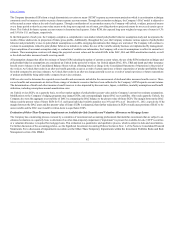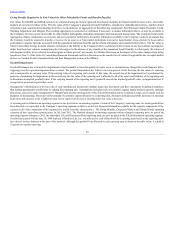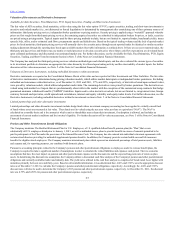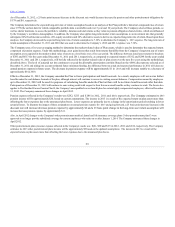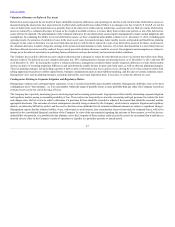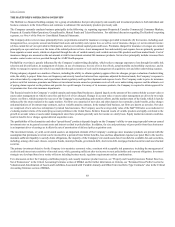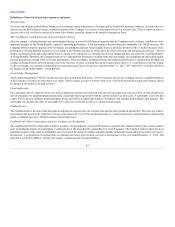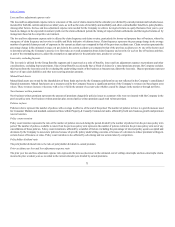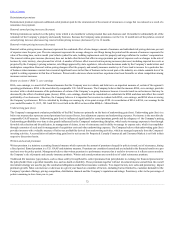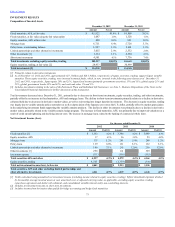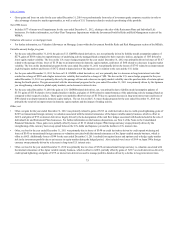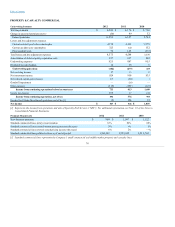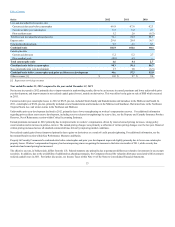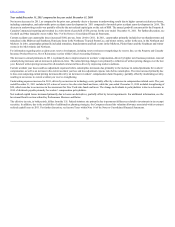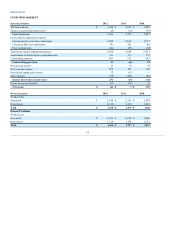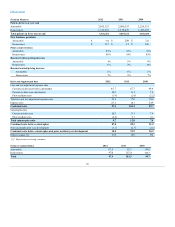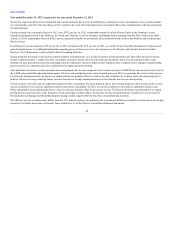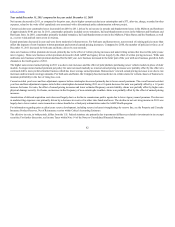The Hartford 2012 Annual Report Download - page 73
Download and view the complete annual report
Please find page 73 of the 2012 The Hartford annual report below. You can navigate through the pages in the report by either clicking on the pages listed below, or by using the keyword search tool below to find specific information within the annual report.
Table of Contents
Reinstatement premiums
Reinstatement premium represents additional ceded premium paid for the reinstatement of the amount of reinsurance coverage that was reduced as a result of a
reinsurance loss payment.
Renewal earned pricing increase (decrease)
Written premiums are earned over the policy term, which is six months for certain personal lines auto business and 12 months for substantially all of the
remainder of the Company’s property and casualty business. Because the Company earns premiums over the 6 to 12 month term of the policies, renewal
earned pricing increases (decreases) lag renewal written pricing increases (decreases) by 6 to 12 months.
Renewal written pricing increase (decrease)
Renewal written pricing increase (decrease) represents the combined effect of rate changes, amount of insurance and individual risk pricing decisions per unit
of exposure since the prior year. The rate component represents the average change in rate filings during the period and the amount of insurance represents the
value of the rating base, such as model year/vehicle symbol for auto, building replacement costs for property and wage inflation for workers’ compensation.
The renewal written price increase (decrease) does not include other factors that affect average premium per unit of exposure such as changes in the mix of
business by state, territory, class plan and tier of risk. A number of factors affect renewal written pricing increases (decreases) including expected loss costs as
projected by the Company’s pricing actuaries, rate filings approved by state regulators, risk selection decisions made by the Company’s underwriters and
marketplace competition. Renewal written pricing changes reflect the property and casualty insurance market cycle. Prices tend to increase for a particular line
of business when insurance carriers have incurred significant losses in that line of business in the recent past or the industry as a whole commits less of its
capital to writing exposures in that line of business. Prices tend to decrease when recent loss experience has been favorable or when competition among
insurance carriers increases.
Return on Assets (“ROA”), core earnings
ROA, core earnings, is a non-GAAP financial measure that the Company uses to evaluate, and believes is an important measure of, certain of the segment’s
operating performance. ROA is the most directly comparable U.S. GAAP measure. The Company believes that the measure ROA, core earnings, provides
investors with a valuable measure of the performance of certain of the Company’s on-going businesses because it reveals trends in our businesses that may be
obscured by the effect of realized gains (losses). ROA, core earnings, should not be considered as a substitute for ROA and does not reflect the overall
profitability of our businesses. Therefore, the Company believes it is important for investors to evaluate both ROA, core earnings, and ROA when reviewing
the Company’s performance. ROA is calculated by dividing core earnings by a two-point average AUM. A reconciliation of ROA to ROA, core earnings for the
years ended December 31, 2012, 2011 and 2010 is set forth in the ROA section within MD&A - Mutual Funds.
Underwriting gain (loss)
The Company's management evaluates profitability of the P&C businesses primarily on the basis of underwriting gain (loss). Underwriting gain (loss) is a
before-tax measure that represents earned premiums less incurred losses, loss adjustment expenses and underwriting expenses. Net income is the most directly
comparable GAAP measure. Underwriting gain (loss) is influenced significantly by earned premium growth and the adequacy of the Company's pricing.
Underwriting profitability over time is also greatly influenced by the Company's underwriting discipline, which seeks to manage exposure to loss through
favorable risk selection and diversification, its management of claims, its use of reinsurance and its ability to manage its expense ratio, which it accomplishes
through economies of scale and its management of acquisition costs and other underwriting expenses. The Company believes that underwriting gain (loss)
provides investors with a valuable measure of before-tax profitability derived from underwriting activities, which are managed separately from the Company's
investing activities. A reconciliation of underwriting gain (loss) to net income for Property & Casualty Commercial and Consumer Markets is set forth in their
respective discussions herein.
Written and earned premiums
Written premium is a statutory accounting financial measure which represents the amount of premiums charged for policies issued, net of reinsurance, during
a fiscal period. Earned premium is a U.S. GAAP and statutory measure. Premiums are considered earned and are included in the financial results on a pro
rata basis over the policy period. Management believes that written premium is a performance measure that is useful to investors as it reflects current trends in
the Company’s sale of property and casualty insurance products. Written and earned premium are recorded net of ceded reinsurance premium.
Traditional life insurance type products, such as those sold by Group Benefits, collect premiums from policyholders in exchange for financial protection for
the policyholder from a specified insurable loss, such as death or disability. These premiums together with net investment income earned from the overall
investment strategy are used to pay the contractual obligations under these insurance contracts. Two major factors, new sales and persistency, impact
premium growth. Sales can increase or decrease in a given year based on a number of factors, including but not limited to, customer demand for the
Company’s product offerings, pricing competition, distribution channels and the Company’s reputation and ratings. Persistency refers to the percentage of
policies remaining in-force from year-to-year.
72


